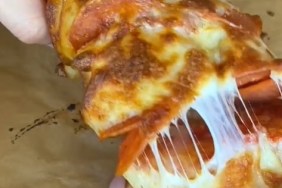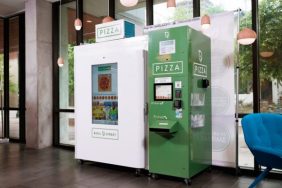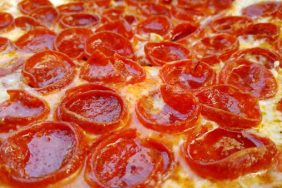Photo: Roasted corn, heirloom cherry tomato, and basil pizza. Courtesy Abrams.

Joe Beddia’s pizza sells itself on sight alone with its crisp-bubbly crust, gooey cheese, and inventive toppings. But if you require credentials, Bon Appétit magazine declared his pies “The Best Pizza in America” in 2015. Beddia opened the humble 300-square-foot Pizzeria Beddia in Philadelphia in 2013. There are no chairs, no phone, and no delivery. Customers endure lengthy lines to get a taste of one of the 40 pies made daily by Beddia. Luckily for those impeded by distance or impatience, the pizza master shares his secrets in the new cookbook, Pizza Camp.
The visually stunning volume explains the basics of pizza dough, shows you how to make your own white and red sauces, and suggests winning topping combos. There are also a few hoagie and stromboli recipes for those (difficult to imagine) days when you just can’t eat another slice of pizza. Throughout, Beddia shares stories from a lifetime of loving food and his previous beer-brewing career as well as photographs and drawings that capture his sense of humor and the spirit of Philadelphia.
We asked Beddia about the new cookbook and his legacy as Philly’s hottest pizza maker.
Crave: Has your business model changed since Bon Appétit called your pizza “The Best Pizza in America”?
Joe Beddia: No. It’s been sort of rough on our regulars because you get people that have never had it that come and wait in long lines and it sort of creates this other thing. But there’s nothing I can really do. We were busy before the article, and then we were extremely busy after. I think we had 26 weeks where we sold out every day. We literally opened the doors and John [Beddia’s sole employee] would take people’s orders and we were out of pizza right away. In ten or 15 minutes, as soon as he could write the orders down, that was all the pizza we had for the night. I bake the pizza, which takes me from 5:30 to 10:30 p.m.
Also: Cookbook Author Advocates “Meat on the Side”
Is there a rule of thumb for when to make a white pizza and when to make a red pizza? Do certain toppings fit better with certain sauces?
There are some things that might work better than others, but it’s not a rule-based thing. I do a lot of fresh greens on pizza – spinach or rainbow chard, different kinds of kale or collared greens. I tend to put those on white pizzas, but on a red pizza they’re still delicious.
So it’s personal preference?
The dough part is an important thing to follow. Once you have that down, you can take some suggestions from what I’m doing, but I really like the idea that people can do with what they have and be creative on their own. That’s how I’ve arrived at the point where I have. There weren’t really any rules. There’s no laws. My thing is: make sure your raw ingredients taste good and they’re of a certain quality. When you put all that stuff together, it’s going to be great.

Photo: Speck, collard greens, fontina, and cream pizza. Courtesy Abrams.
Why is a pizza stone essential?
You’re not going to get the desired crispiness of the crust if you just put it on a sheet tray and bake it. It’s more of a texture thing.
One misconception about pizza-making is that you should put all the toppings on and then bake the pizza. But you say some toppings should be withheld until after the pizza is baked.
It’s the same as if you’re thinking about a pasta dish. You’re finishing pasta with extra virgin olive oil, with grated cheese. Parmesan will be good baked on the pizza, but it’s also great when it’s not baked, because you have so many nuanced flavors that you just cook them out. I use the pickled chilies and pickled serranos and they have a really great crunch to them; I really enjoy the texture of those. Once you cook it, it just kind of all melts together, which is fine, but if you want a little more pop, it’s best to leave it off [until after baking]. For instance, nice anchovies are going to have a nuanced flavor; as soon as you cook them, they become fishy. It’s once luscious and beautiful, it’s almost like an umami type thing, this really rich thing; if you cook them, it loses that.

Photo: Courtesy Abrams.
Do you ever get tired of pizza?
Honestly, I rarely eat it. I probably eat pizza once a month. I sell all the dough that I make. We sell 40 pizzas. That means there’s zero left for me. Which is fine. I’ve eaten plenty of pizza.
Given your success, have you been tempted to expand?
Oh, yeah, yeah, yeah. I’m talking about it right now. At the end of this year, it will be the end of my five-year lease, and I have the opportunity to renew it but I’m probably not going to.
You’re moving somewhere bigger?
I don’t know exactly yet. It’s just a lot. If I started cooking when I was 20, I probably could have done it for 20 years. But I started the pizza shop when I was 36 and now I’m 40 and it’s like going in at nine in the morning and working until eleven at night. If you think about it in dog years, five years seems like 20 years. It’s a little rough. It’s hard to have a regular life, I guess.
I’m definitely grateful for everything. When you work really hard and somebody sees that and they appreciate it, that feels amazing. If I can help the world make better pizza, that’s awesome.








